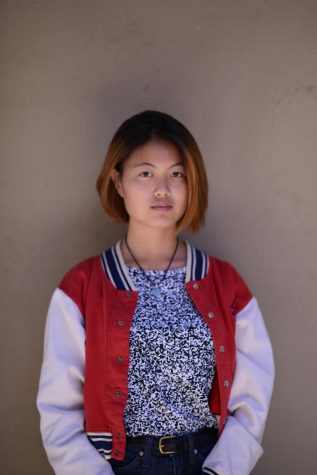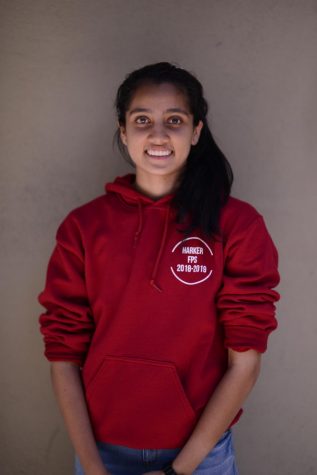Humans of Harker: Learning to fall
Anya Gert (‘20) translates passion into skill
“[Volleyball has] taught me how to fall correctly, and another thing it taught is that you don’t have to be the best at something to be good at it. If you just hit the ball in a smart way, then it still scores points and you’re good at it. You could be a background player and still make a much bigger impact on the team than you would think,” Anya Gert (’20) said.
The sun begins its descent behind the mountains at Rancho San Antonio as Anya Gert (‘20) fiddles with a leaf. A lanyard with her car keys swings from her pocket, jostled as she takes in the different angles of the autumn foliage.
Those who know Anya know that she loves the outdoors. From hiking to mushroom-picking to skiing, Anya spends much of her free time in nature — yet, this wasn’t always the case.
“When I was a child and I started skiing, my parents had a leash because I was scared and they didn’t want me to accelerate and fall on my face,” she said, laughing. “I was terrified, but now I like skiing and there are moments when I remember I had my parents holding me on a leash to make me not scared.”
The same fear of falling — both literally and metaphorically — found its way into other aspects of Anya’s life, like volleyball. Having played the sport since a young age, she credits the sport with teaching her how to persevere through ups and downs.
“[Volleyball has] taught me how to fall correctly, and another thing it taught is that you don’t have to be the best at something to be good at it,” she said. “If you just hit the ball in a smart way, then it still scores points and you’re good at it. You could be a background player and still make a much bigger impact on the team than you would think.”
And the years of volleyball paid off — as a senior starter on last year’s girls volleyball team, Anya helped lead the team to its first Central Coast Section (CCS) championship.
“[Watching] her team and her come together and win girls’ volleyball’s first-ever CCS championship — that’s pretty insane, right? I know how much work she put in and just the energy in the crowd, everyone supporting the team [made it] really memorable,” close friend Henry Wiese (‘20) said.
A similar philosophy finds its way into Anya’s art — owning the imperfections to ultimately craft something meaningful.
“I feel like I always hype [the art] up in my head, even though it’s probably not going to turn out the way I want it to. In the end, it just expresses what I want it to express anyway. The meaning evolves as I do it,” Anya said.
In creating the art, she emphasizes how it in turn has a profound impact upon her, helping Anya better understand herself.
“It used to be just about images because it was just cool to draw, but as you grow up, I think you get to understand yourself further because you’re making the art more personal,” Anya said. “I think in general, when I use my sketchbook, I don’t have the technical skill that a lot of people have and I’m well aware of that […], but it’s more of the idea that counts. I just focus on the idea instead of what it actually looks like.”
Anya’s passion for art also translated into her experience as a Mitra Scholar researching the street art of Occupied West Berlin.
“She puts her whole heart into what she does,” close friend Sejal Krishnan (‘20) said. “She did the unorthodox thing of analyzing Berlin [street] art, which is very different from the typical literary analysis of history.”
Anya’s wholehearted passion for the activities she pursues derives from a larger ability to reach beyond the orthodox, surprising her peers with her out-of-the-box insights.
“She’s always willing to go beyond what everyone thinks of the norm. And it’s really funny because you’re like, ‘No, that’s weird,’ but then you’re like, ‘No, wait, that’s really funny,’” Sejal said. “It just made me more open about how I perceive other things around me.”
Close friend Anika Tiwari (‘20) highlights Anya’s ability to empathize with her friends’ sentiments and offer discerning perspectives.
“Anya’s really carefree and plays into her emotions a lot. Having someone like her in my life made me more in tune to my emotions and more sensitive to the people around me,” Anika said.
Anya goes against the current in her own way and, through example, encourages others to do the same. In her work — whether in the realm of volleyball, art, or research — she rolls with the punches, quietly building on her accomplishments.
“[Anya] has taught me to be aware of the quietude of achievement and to be understanding that oftentimes, the people who are the most dedicated or the most willing to be dedicated to something don’t tell you that. You have to observe it,” Halback said.

Jin Tuan (12), co-design editor of the Winged Post, is a brown paper bag going through senior year. You're not quite sure what's in it, but whatever...

Aditya Singhvi (12) is a co-managing editor of Harker Aquila. This is his fourth year on staff. Outside of journalism, he enjoys running and watching...

Saloni Shah (12) is the editor-in-chief of Humans of Harker. This is her fourth year on staff. She loves to spend time with the rest of the staff and...


















![“[Building nerf blasters] became this outlet of creativity for me that hasn't been matched by anything else. The process [of] making a build complete to your desire is such a painstakingly difficult process, but I've had to learn from [the skills needed from] soldering to proper painting. There's so many different options for everything, if you think about it, it exists. The best part is [that] if it doesn't exist, you can build it yourself," Ishaan Parate said.](https://harkeraquila.com/wp-content/uploads/2022/08/DSC_8149-900x604.jpg)




![“When I came into high school, I was ready to be a follower. But DECA was a game changer for me. It helped me overcome my fear of public speaking, and it's played such a major role in who I've become today. To be able to successfully lead a chapter of 150 students, an officer team and be one of the upperclassmen I once really admired is something I'm [really] proud of,” Anvitha Tummala ('21) said.](https://harkeraquila.com/wp-content/uploads/2021/07/Screen-Shot-2021-07-25-at-9.50.05-AM-900x594.png)







![“I think getting up in the morning and having a sense of purpose [is exciting]. I think without a certain amount of drive, life is kind of obsolete and mundane, and I think having that every single day is what makes each day unique and kind of makes life exciting,” Neymika Jain (12) said.](https://harkeraquila.com/wp-content/uploads/2017/06/Screen-Shot-2017-06-03-at-4.54.16-PM.png)








![“My slogan is ‘slow feet, don’t eat, and I’m hungry.’ You need to run fast to get where you are–you aren't going to get those championships if you aren't fast,” Angel Cervantes (12) said. “I want to do well in school on my tests and in track and win championships for my team. I live by that, [and] I can do that anywhere: in the classroom or on the field.”](https://harkeraquila.com/wp-content/uploads/2018/06/DSC5146-900x601.jpg)
![“[Volleyball has] taught me how to fall correctly, and another thing it taught is that you don’t have to be the best at something to be good at it. If you just hit the ball in a smart way, then it still scores points and you’re good at it. You could be a background player and still make a much bigger impact on the team than you would think,” Anya Gert (’20) said.](https://harkeraquila.com/wp-content/uploads/2020/06/AnnaGert_JinTuan_HoHPhotoEdited-600x900.jpeg)

![“I'm not nearly there yet, but [my confidence has] definitely been getting better since I was pretty shy and timid coming into Harker my freshman year. I know that there's a lot of people that are really confident in what they do, and I really admire them. Everyone's so driven and that has really pushed me to kind of try to find my own place in high school and be more confident,” Alyssa Huang (’20) said.](https://harkeraquila.com/wp-content/uploads/2020/06/AlyssaHuang_EmilyChen_HoHPhoto-900x749.jpeg)


